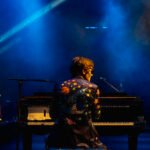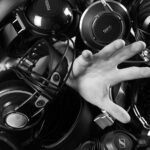Hello all you EJ fans, my name is Leroy Gomes (AKA Gomez), and I had the pleasure to work on the Goodbye Yellow Brick Road album for Sir Elton John.
I’ve been asked by Cheryl Herman, Chief Editor of Elton John World, to answer some questions about how I got the call to work on Elton’s album, and to give some insight on the recording. Also some information about who I am, where I’ve been, and what I am doing now… So here goes.
I am an American, born in New England on Cape Cod Massachusetts. I began playing the saxophone at the age of 12 and started my professional musical career performing with the group Tavares at the age of 17.
While on tour with the group in Europe, I fell in love with Paris and decided to stay. After a couple of years working as a session musician and playing with various French artists and bands, I built a reputation of being one of the top session musicians in Paris, and I guess this leads up to the part that everyone wants to hear about. How I got the call to perform on Goodbye Yellow Brick Road, and to give some insight on how it went. . . .
In 1973, I was playing in a French American band and we all lived together in a big house in Pantin , a small town situated just on the outskirts of Paris. One evening I was in the living room working on my guitar skills and learning to play some songs that I liked. Now as fate would have it, one of the tunes I was working on was a beautiful love song called Your Song, sung by; you guessed it, Elton John. I was beginning to sing the chorus “now you can tell everybody, this is your song…..”(my favourite part) when Hugo Napier, our guitar player, ran into the room to tell me that he just got of the telephone with a recording friend of mine, Michael McEwan, who told him that Elton was recording his new album at Strawberry Studios located in the Chateau d’ Herouville, about 50 kilometers away from us. Apparently Elton was looking for a sax player to perform on his new album, but that after several attempts with a couple of local musicians, he couldn’t find what he was looking for. Hugo added that Michael was on his way to pick me up to take me directly to the studio to offer my services.
I thought that this was a bad idea. I did not see myself just barging in on Elton’s recording session, uninvited. So I turned around and got back to practicing my guitar. Well that did not sit well with Hugo and the boys in the band. They thought I was crazy to pass up this opportunity, but quite frankly I was a little worried about being rejected. After all this was an Elton John session! When Michael finally arrived at the house, there was no stopping these guys, they literally grabbed my sax and I and threw us into Michael’s Volkswagen van, all the while assuring me that I was the best man for the job. But still, I kept on protesting. So, on the way Michael stopped at our favourite French café, and I ordered a couple of my preferred drinks in those days, a brown beer called Pelforth. Anyway after a couple of beers, I was more cooperative.
After a while, it was time to leave the café, but Michael thought it would be a little intrusive for everyone to show up for this gig. Especially because by then it was around eleven o’clock at night and we still had to drive to the studio. So Hugo and the boys agreed to stay at the café. Michael and I jumped back into the van and headed out to Chateau d’ Herouville.
We arrived at the studio around midnight. Strawberry Studios had two recording rooms and Elton was recording in the studio situated up in the loft on the top floor of the Chateau d’ Herouville. Between us, we called it “The Attic”. It was not the big recording room at the Chateau. In the main studio you could record and orchestra if you wanted. But the attic was where all the intimate stuff was recorded. It was comfortable and cozy and a great place to record vocals, guitar, piano and solos, or if you had a small band and wanted to get a live sound, it was perfect. I guess that’s why so many of the great artists like David Bowie, Pink Floyd, Fleetwood Mac, Cat Stevens and the Bee Gees, who later recorded Saturday Night Fever, all recorded at the Chateau d’ Herouville. Even as far back as the 18th Century artists such as Frederic Chopin and Vincent van Gogh frequently hung out at the Chateau. Sorry, there is just so much history there, I had to mention it. Let’s get back to Elton.
So we entered the studio by the back stairs. An entrance typically used to bring equipment into the recording room. We climb the long stairway that led up to a sound-proof door. Next to the door there was a red light which is turned on only when someone was recording. The light was on, so we sat quietly on the stairs waiting for the light to go out giving us the opportunity to enter the studio. It was quite cold at this time of night but we were patient. In the silence we could faintly hear someone singing on the other side of the door, it was Elton recording the lead vocals to the title track of the album Goodbye Yellow Brick Road: “Oh I’ve finally decided my future lies Beyond The Yellow Brick Ro o oad Ah Ah Ah Ah Ah…” We did not know it at the time, but we had arrived at the precise moment of some magical musical history.
When the red light finally went out, I hesitated and asked Michael if this was really a good idea, after a little more persuading, I gave in and he opened the door and we just strolled into the studio. By that time, Elton had left the recording booth and was sitting at the piano. Apparently he was about to record some piano when we popped in. Before anyone could say a word Michael said, “Hey, Elton, I heard that you’ve been looking for a sax player to lay down some tracks, well, here he is.” I am sure most superstars would have been upset to have a couple of guys just barge into their recording session, but not Elton. He just coolly and calmly looked at us and said “Great!” Then he looked up at his team in the recording booth and said: “O.K. change of plans, let’s record some sax.”
Elton invited Michael to go up with him into the control booth while I set up my sax and the assistant engineer provided me with some headphones and set up my microphone. . . . Now to give you a little insight on the recording process, there are several ways to get the music on tape: Most times the music is written on charts and locked in, then you read the music and try to put some interpretation into it, but what Elton wanted from me was an improvised sax solo. So it was up to me to listen to the track, get into the groove of what was already recorded and drop in my solo. It’s all about feelings.
Elton and his team were relay cool and gave great vibes, no stress. There was Bernie Taupin, Elton’s famous writing partner, David Hentschel his engineer, I believe Andy Scott was the assistant engineer, and Gus Dudgeon the producer of the album. So we started to work. First, we established a good balance in the headphones and they let me hear the track a couple of times as I played along with the music. Then in the headphones I heard someone say, “great let’s record.” The red light was turned on outside by the stairs and I recorded my solo.
That night, I was also asked to solo on a second song, so I recorded my sax on this track as well. . . . When an artist of Elton’s calibre goes into the studio, they always record more than needed and only pick what they feel is the best material to be included into the finished product. But this second song was not chosen to ease on down The Yellow Brick Road. It was called Screw You – Young Man’s Blues, and was released as the B side of a Goodbye Yellow Brick Road 45 released in the United States in 1973. But the title was changed to – Young Man’s Blues – in order to not offend the American public. Luckily for me, the first song that I soloed on did become a part of the album; the song is called Social Disease.
The rest of the night was amazing. Normally after a recording, the protocol was that I would pack up my sax, be paid, say thank you and leave. And for me that was always fine. But not with Elton and his mates, there was a different ambiance. It was like they let us in to sit at the round table as they discussed and contemplated the strategies of getting the music recorded just right. We were allowed to stay and watch as the Knights of the Round Table worked on one of Sir Elton’s greatest works. They worked all night as we watched them create. It was awesome! I learned some recording and editing techniques that I still use to this day.
In the morning, we all had breakfast together. We eat outside on some picnic tables while reflecting on the night that had passed. After a while, we decided to head on back to Paris so we got up to leave. As we were saying goodbye to everyone Elton shook my hand and asked me how much he should pay me for my work. We never talk about money and quite frankly, I had forgotten all about getting paid. So I quoted him the price that I would usually charge for a recording session. Elton looked me right in the eyes and said: “You’re worth more than that,” and paid me double what I had asked him. Then he told me that I should not sell myself short and should charge more for my work, because I deserved it. To think that just twelve hours prior to this moment, I was worried about being rejected, but ended up sitting at the “Round Table” with legends!
So now to the next to last question that Cheryl wants me to answer, what happened after Goodbye Yellow Brick Road. Well after this uplifting experience with Elton, I continued my musical journey working in studios and performing as a singer, song writer and saxophone player in different formats, constantly working on my solo career and always charging, not double like Elton suggested, but a little bit more for my work.
Michael and I continued recording together on different projects and in the following year recorded with a studio project called Lafayette Afro Rock Band in which we both wrote songs: my song Hihache and Michael’s Darkest Light. Never charted but years later, these two songs ended up being sampled regularly by artists as diverse as Janet Jackson, Madonna, Jay-Z‘s Show Me What You Got, Amy Winehouse, Peter Gabriel, LL Cool J, Naughty by Nature, and Wu-Tang Clan – and the list goes on and on. Over the years, over 130 artists have sampled our songs collectively. Michael always says: “We’re the Godfathers of Hip Hop.”
Then in 1977, at the height of the disco era, I sang on an album called Santa Esmeralda, reinventing an old Blues classic, first sung by Nina Simone in 1964 and then covered by the group the Animals in 1967. The song was Don’t Let Me Be Misunderstood. My interpretation of this classic had a new arrangement, a new style that got labeled as Disco Flamenco. It was a hit for Nina and the Animals in the sixties and again for me in 1977, ten years later. My version of this classic sold over 12 million albums in a few months and played worldwide in every discotheque.
Now, to answer the last question that Cheryl wanted me to answer, what am I doing now?
Well, it’s a long road from Elton John’s Goodbye Yellow Brick Road to Santa Esmeralda Starring Leroy Gomez, and Don’t Let Me be Misunderstood. I am still living in France, and perform under the name of Santa Esmeralda, Starring Leroy Gomez.
But still it’s a long story. The best way to answer this question for those of you who may be interested, I suggest that you log on to my official Web site, www.santaesmeralda.net.
Meanwhile, I would like to thank Cheryl and Elton John World for asking me to relive ‘One Night on the Yellow Brick Road.’ It brought back memories of good times, good music and good people who believed in me more than I believed in myself.








